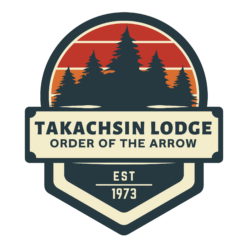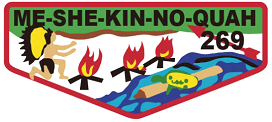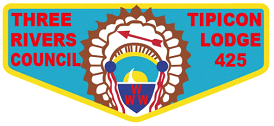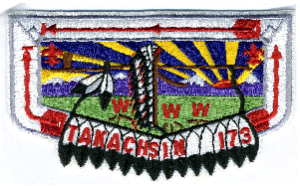Name: Ojibwa 173
Founded: Fall 1939 (chartered in 1940)
Council: Harrison Trails Council, Lafayette first council Lafayette Council founded 1921
meaning: An Algonquin Tribe, Chippewa
Totem: Cabin superimposed on arrowhead
Unlike the other two merged lodges who had other honor camping programs (other than the OA), records indicate that in 1939, the lodge was formed in the OA as the initial camping honor program. The lodge had 16 charter members who worked in the Fall of 1939 to come up with its constitution and was charted in 1940.
This council’s OA program was the 173rd lodge to register with the Order of the Arrow. The lodge did issue a round patch along with several variations (primarily border color) of its lodge flap. One time, the patch company made an error and instead of Ojibwa, they made it Opibwa. They also issued neckerchiefs.
The first advisor was Robert Hayes from 1940 to 1957, and the second and final advisor was Frances Lee from 1957 to 1972 (until the merger). At the time of the merger, Frances Lee was Lodge Advisor.
Name: Me-She-Kin-No-Quah 269
Founded: 1944 as Akonequa, changed in 1946 to MeShe-Kin-No-QuahCouncil: Meshingomeshia Council, Marion
first council (Grant County) 1918
meaning: Little Turtle
Totem: Turtle
The scouts of Meshingomeshia Council first organized into a different camping honor program other than the Order of the Arrow. That program was called Tipisa, Order of the Red Lodge. The program originated in Michigan by a Scout Executive named George Crossland. He transferred to Marion and brought a
chapter of Tipisa with him. This started in the mid1930’s. (This is where the name for the Boy Scout camp came from, Crossland Scout Reservation, in
honor of George Crossland). In 1944, the members of Tipisa went through a
conversion ceremony and became members of the Order of the Arrow. The lodge was originally called Akonequa, but in 1946 changed its name to Me-SheKin-No-Quah, the name of a mighty chief of the Miami Indians. Little Turtle (as it is translated) defeated Mad Anthony Wayne at Fallen Timbers in 1794.
The lodge issued a round patch, turtle patch(es), along with some variations of lodge flaps along with neckerchiefs. At the time of the merger, Phil Deardorff was Lodge Advisor.
Name: Tipicon 425
Founded: 1949 as Chippewa, changed in 1952 to Tipicon.
Council: Three Rivers Council, Logansport
Logansport council founded in 1918.
meaning: Fish in Potawatomi
Totem: “tipping canoe”
In 1921, the scouts of this council formed a Tribe Of Gimogash which was another contending youth program. The Tribe of Gimogash is actually older than
the Order of the Arrow. The Tribe of Gimogash had purposely no national structure, no dues to be paid to a national unit, which ultimately led to its demise.
In 1949 (the BSA adopted OA as the official program in 1948), members of the Tribe of Gimogash went through a ceremony and became Order of the Arrow members.
Initially the lodge was called Chippewa but that was changed to Tipicon in 1952.
The totem of a tipping canoe is a bit of play on words since Camp Buffalo is located on the Tippicanoe River.
The Lodge issued 4 patches not counting the section patches, etc. The first was a round 3″ patch, then a cut edge headdress patch, the the conventional lodge flap in two flavors a restricted and a trader. One could buy as many trading flaps but only one or two restricted a year (as memory serves me). There was also neckerchiefs. At the time of the merger, Hal Ivey was lodge advisor.
In January 1973, three lodges merged (due to their councils merging) to form Takachsin Lodge. Takachsin means “Leader”. The totem is the Calumet (peace pipe). The original lodge flap was designed by Ron Huffman of #269. Due to National BSA requiring either fluer-de-lis or BSA, FDL were added in 1974 and moved from grass to sky in later runs. The Lodge ran with design even for most of its NOAC and anniversary issues for nearly 40 years. National regulations did not allow the feathers to hang below the pocket flap. So the lodge has created other lodge flaps.
The first annual banquet of the Lodge was to take place December 1984 at Logansport but due to bad weather was postponed to February 1985. In latter 1985 at the second annual banquet held at Cary Camp, a special flap celebrating the 75th anniversary of Scouting was presented to all present. This was our first special flap issued.
In November 2015, a special ashes and rededication ceremony was held called ReKindle the Fire at Camp Buffalo, to remember the 1st century of OA and move
forth in the 2nd century.
Why Merge?
The Boy Scouts of America in the late 1960’s had a study done for the future. It was determined that financially smaller councils would not be able to survive but by merging, this would eliminate staff, as you only needed one Scout Executive, one registrar, (etc.) not 2 or 3.
National had a plan that said something like folks at Lafayette, shop in Champagne, IL and so they should merge that way. Folks in Marion shop in Fort Wayne and they should merge with that council and the folks at Logansport shop at South Bend (or was it Indy?), and should merge that way.
None of the three councils were happy about it. So they got together and merged with each other. Now I will not go into the politics of such because it is part of the big fish in a small fishbowl that all of a sudden we had a bigger fish bowl and more “big” fish. To say it politely, both on the council level and on the lodge level there were a few struggles. As part of the lodge merger, many “rules” were set up.
These rules covered trying to be “fair” to the merging three lodges so that “everything” did not come from one lodge. We took 173 from 173, the first chief came from 425 and the patch design came from a member of 269. We avoided using any totem or name from the former three lodges. All three advisors were in the new advisor group, Hal Ivey from 425 was made the head advisor with Phil Deardorff (269) and Frances Lee (173) as Associate Advisors. Hal
Ivey died in 1979, and Phil became the lodge advisor.
The lodge has hosted several section conclaves and was the service lodge to the 1994 NOAC held at Purdue University.
In October 1987, the council office burned down and the OA lodge lost over $5000 in flaps, sashes, neckerchiefs, books, regalia, etc. The lodge issued a “black” lodge flap, known as the fire flap, and with the efforts of one OA member, most all of the cloth goods were salvaged even though they sat in 8 foot of “black” water for a week.




